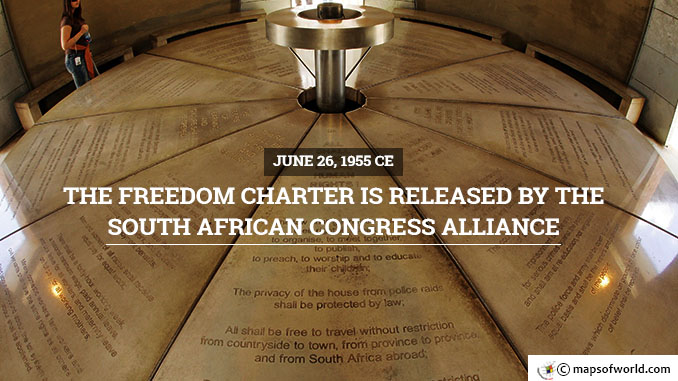Three years after the start of the Defiance Campaign in South Africa, the anti-Apartheid movement had been growing in strength with little to show for it. A series of peaceful demonstrations and violent responses – the Sharpeville Massacre, Soweto Uprising, Cape Town Peace March and more – several groups left out in the cold by the South African government gathered to compose a list of demands, which were made public on June 26, 1955. In late 1951, after years of mistreatment by the white minority government, the African National Congress presented its directions for a non-cooperative protest against unbalanced statues on the books. The Defiance Campaign Against Unjust Laws began in earnest with a demonstration on April 6, 1952 – the 300th anniversary of white settlement in South Africa. Tension mounted as time passed. Leading activists were soon tailed by government officials, with many of them jailed multiple times. Some, such as Nelson Mandela, ended up facing sanctions akin to house arrest in an attempt to minimize the effectiveness of the protests. With so many organizations from differing backgrounds – groups often were split along racial or professional lines – it soon became clear the disenfranchised masses needed a clear statement to unite the pursuit of freedom. With this in mind, a Congress of the People was set to convene in Kliptown of the Soweto district in Johannesburg. The African National Congress (ANC) gathered some fifty thousand volunteers to help survey the unrepresented populations, directing them into the poverty-stricken areas around the South African capital and throughout the country to collect ideas about what freedom would look like. The collected answers – land for all, living wages and free education regardless of race among them – would then be codified into a central document on June 26. More than 3,000 delegates gathered for the meeting, predominantly from four groups: the ANC, South African Indian Congress, South African Congress of Democrats and the Couloured People’s Congress. Thousands more gathered outside, awaiting the proclamation to come –including Mandela, who disguised himself as a milkman to avoid capture for violating restrictions placed on his movements by police. The meeting would be broken up the next day, but not before each tenet of the Freedom Charter had been read aloud by organizers. Those outside acclaimed each point – beginning with the opening statement “The People Will Govern!” – with a shout of “Africa!” or “Mayubiye!” (“Come back!”) The basic guarantees, designed to ensure all South Africans had basic human rights, would become a rallying cry for nearly four decades in the struggle against Apartheid. In the wake of the Freedom Charter, the government accused the ANC of treason and arrested 156 of its most vocal activists, such as Mandela, who would be imprisoned in 1962. Despite the crackdown, the document continued to circulate between the protesters driven underground. During the 1980s, as the foundation of Apartheid began to crumble, the rights enumerated in the charter became the driving force behind the next generation of political activists. After the ANC took power in 1994, much of the issues addressed by the Freedom Charter found their way into the articles contained in the Constitution of South Africa – only the nationalization of industries and redistribution would be left out.
June 26, 1955 CE – The Freedom Charter is Released by the South African Congress Alliance
Three years after the start of the Defiance Campaign in South Africa, the anti-Apartheid movement had been growing in strength with little to show for it. A series of peaceful…
372
